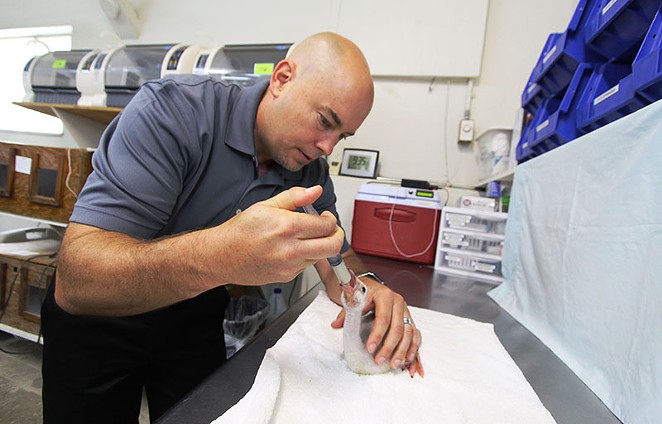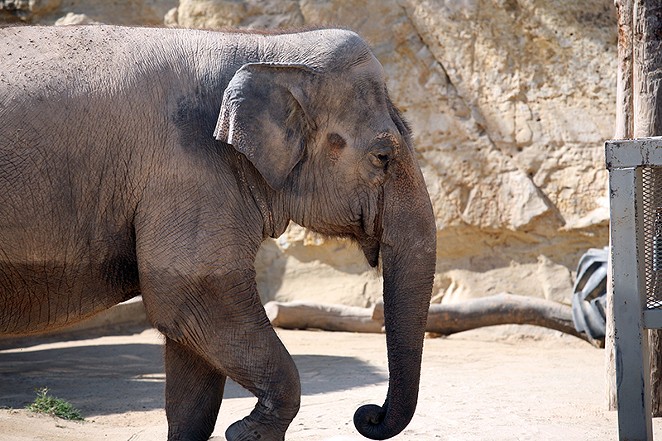
After nearly two decades working at SeaWorld, Tim Morrow thought he was basically set for life – planning to stay with the company until retirement.
Then he got a call from a recruiter asking if he'd be interested in the top post at the San Antonio Zoo. His initial reaction was to say he was all set, but then he thought about it some more and decided to go for it.
Now he finds himself closing in on nearly a year at the helm of the venerable Alamo City institution, home to one million visitors a year.
Morrow, 44, a San Antonio native who graduated from UTSA, sat down with the San Antonio Current last month to discuss how his tenure has gone so far, including having to deal with controversy over the zoo's handling of its lone and aging elephant resident, Lucky.
Critics contend she needs to be moved to a better location but the zoo maintains she's better off staying put.
What was your first impression of the place? Anything surprise you?
I had no idea that it was a nonprofit. I thought it was the city running the zoo. I was really surprised by how much conservation the zoo does. You don't hear about it a lot. It's hard to get all the messaging out, but I was shocked by how much it does. And I really dig how much people love the zoo.
What were some of the initial challenges you set out to tackle?
It's a historic area and it's very tight. We're on Brackenridge Park property, and we've got the DoSeum across the park, the Witte, Kiddie Park, Botanical Gardens, Japanese Tea Gardens and then the Pearl right across the highway. This whole area has really become the hot part of town, so that's great but it does give us some infrastructure limitations. This museum was state of the art when it opened, a lot of cageless exhibits, great staff, great vets, but zoos are going through this evolution process of bigger, more natural and more enriching spaces for the animals and this zoo presents a challenge for that because of its historic attributes ... you have to respect the history while you're forging the future at the same time.

What about the issue of what to do with Lucky? She continues to garner headlines.
I've probably done more interviews about Lucky than anything else in my time so far here at the zoo. We need to do a better job in educating people on Lucky's situation. There are activists that want Lucky moved to another location or people ask why can't you bring other elephants in to be with her? I had the same questions when I came in here. I met with the elephant staff [seven full-time keepers], got their input on what's going on, why are they doing the things they're doing, what they think we should do ... After meeting with them, I think the zoo's making the right decision. She's 55 and a half years old, she has outlived the average life span by nine years and we have concerns that moving her would kill her ... She's like your great-grandma – like 90 — in people years. So that stress alone we think could have really bad consequences for her up to and possibly including dying. At her age and her size, even if she made it to another location, she'd have to go through the process of fitting into a herd since she'd have to prove herself in the pecking order and we don't know if she'd survive that.
So how do you react to the criticism about her treatment at the zoo? Is any of it fair?
I understand the perception that they see Lucky all by herself. We want to project our human feelings on her and we think, 'I'd be so lonely if I was her.' But we've seen that she's healthier and happier by herself. The last elephant that she was with, Boo, on paper looked like a great elephant. Boo has gotten along well with others, was not aggressive. But the first thing that Boo did was knock Lucky down on her back side and the rest of the time they were together, Lucky stayed by herself in one spot. They didn't like each other. Lucky was intimidated, which is what happens in the elephant world – someone's the boss and someone's not. Now she's more relaxed back by herself, strolling along the whole yard. But the perception continues to be that there's a lonely elephant, and I totally get that.
So how do you deal with activists demanding change?
Some of the activists have an anti-zoo agenda; they don't want zoos, period. I feel it's a bit shortsighted and not looking deep into what's really happening in the world ... People that work here love animals. Critics also love animals. We know that. We just have different philosophies on how they should be taken care of ... There's a very romanticized view of what the wild is and what's happening out in Africa or Asia. We see poaching everywhere – elephants, tigers, lions, giraffes are being poached for medicinal purposes or for fur or for their bones. So when people are saying let all the animals back in the wild, there really is no wild, it's just little fragments of nature being encroached on daily by man. Back when they started in the late 1800s and early 1900s, zoos were more of a novelty ... but now they're becoming a Noah's Ark and they're going to have to save these animals. Asian elephants like Lucky, there are probably only like 30,000 or 35,000 left, so they're going away in alarming rates. So they're going to be gone in the wild in 20-30 years. Poaching is big business like drugs, it's scary.

What about other problems with other animals? Others have died in captivity.
Yes, they do die, it's the circle of life. This zoo has set records for animal longevity. Yeah, you can put out a list of people who died in San Antonio last year, but it doesn't mean that San Antonio's a bad place for people to live. It just happens. Animals have the same ailments we have as we get older. Some animals get cancer, some die from old age. It's easy for someone to point out all the animals that have died at the zoo. But that's what happens, to all of us. We're regulated by the federal government, by state agencies, by accreditation organizations. It's counterproductive for a quality zoo to not be taking great care of their animals.
You mentioned zoos have changed their philosophy over time – their mission is different from what it once was?
I think there's a change in the field of animals in captivity and that's why zoos are going through an evolutionary process. Our exhibits just can't be like they were in the early 1900s, 1950s, even 1980s. They need to be more natural and enriching for the animals. We want to mix species together. Big, wider, open spaces like you'd see where they come from. People are questioning animals in captivity. It's not a bad thing. It pushes you to make you better.
You also said that people don't get to hear about the zoo's conservation efforts?
We need to do a much better job of talking about the conservation that we're doing around the world. Right now, our conservation vice president is in the Gulf of Mexico doing deep-sea exploration on the effects of the oil spill. We're doing conservation work in Chile and Peru and Mexico, Puerto Rico and right here in the Edwards Aquifer. We need to explain and show people that every time they buy a ticket or a snow cone, that money is going into conservation and research.

